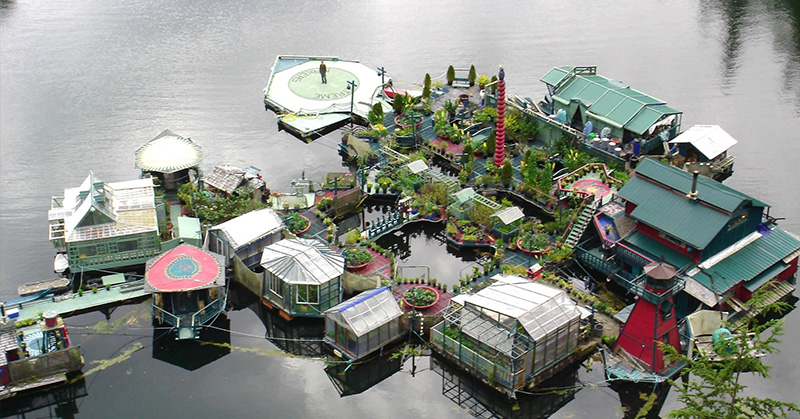Everyone has their own idea of their dream home. For some people, it’s all about residing in some beautiful location, whether that means in the heart of a bustling city or somewhere in the middle of nowhere. Others dream about the interior, whether it’s huge or quaint, regal or cozy.
Wayne Adams and Catherine King also had an idea for their dream home, and they began building it about 20 years ago. Their home may seem outlandish but it’s making people reconsider what they want for a future home, and what may be possible.
Adams, 66, and King, 59, have dubbed their dwelling ‘Freedom Cove,’ and it looks like a small, private island floating off the coast of Vancouver Island, British Columbia. It was built on 12 separate floating platforms and includes five greenhouses, an art gallery, a dance floor, a studio where the couple lives, and a guest lighthouse. All of this is painted in bright shades of teal and hot pink.
“We wanted to live close to nature because as artists that’s what inspires us. That’s why we decided to build this floating home. It works ecologically, in order to limit as much as possible its impact on the environment,” said King.
How Do They Live on a Floating Island?
Freedom Cove is also self-sustainable. The half-acre of land is used to grow and harvest crops. The couple retrieves water from a waterfall during the summer and collects rainwater during the winter. Pipes carry the water to their crops and wherever it’s needed in their house.
With their crop and fishing equipment, they are able to produce their own healthy food supply. Adams could paddle out on a canoe to fish or choose to fish indoors from a trapdoor in his home, from the comfort of his couch.
They used to have 14 solar panels for electricity and heat, but when they broke, they got a generator. They do not have a fridge or freezer, which not only saves power, but gives them the opportunity to eat fresh food every day.
The floating garden is made entirely from recycled materials, like salvaging steel from fish farms to replace rotting wooden platforms.
The garden is filled with vegetables, herbs, berries, edible plans, and fruit trees, and the greenhouses grow food all year round.
“We also do lots of composting,” said King. “As a result, we always eat food that’s fresh and seasonal.”
However, the couple admits that they are not entirely self-sustainable, or at least they don’t choose to be. Every few weeks, they head to town to buy whatever they need or want, like cereal. Adams buys meat on occasion, while his wife is a strict vegetarian.
“As a rule of thumb, we consume fairly little and try to avoid food wrapping as much as possible,” said King.
When the couple is not busy farming, they are working on their art, which includes composing music, writing, carving, painting, dancing, and writing. They also give tours of their island home, if you’re interested in seeing it yourself. The couple supports themselves by selling their art to local shops.
Read: These Self-Sufficient Island Cabins Have All the Comforts of Home
The Building of Freedom Cove
The construction for Freedom Cove began in 1992, almost by complete coincidence. That winter had been brutal and a storm tore down many trees in Adams’s area.
“We gathered all the wood up, took it to the fellow who owned it, but he said to keep it. So we thought, time to start on the home,” said Adams.
Using the lumber, they began to build with old fish-farm technology to keep it buoyant, while using the old-fashioned handsel and hammer, no power tools. Their island is tied to shore with thick lines instead of using an anchor.
Adam explained that he has been building tree forts since he was seven. “And I’m like ‘Dad, I’m building a tree fort in the ocean.’”
They raised their two children on their floating garden. “Living in the wilderness is constant inspiration,” said King. “It’s so incredible to wake up every morning and see all of this.” [3]
Obstacles to Living on a Floating Island.
They tried to keep hens but this proved difficult when they attracted predators. Pests are not alien to Freedom Cove; the Adams had to contend with a rat who seemed bent on damaging the structure’s foundation.
One of the biggest issues the couple faces are winter storms. They use canvas sheets to shield their crops and connect their platforms to shore with thick rope.
“When we first started living on the island, all we had to do was pay tax to the regional and municipal authorities. That’s still the case, right up to this day. But now, it’s no longer possible to build floating homes in the area,” said King. “We’re the only people living in such a house in the entire region. Everyone that comes to visit us — loads of people — tell us that our house is one of a kind.” [4]
When asked if he ever gets seasick, Adams grinned. “No, but when I go to town, I get land-sick.” [5]
Read More: 10 Perfect Places In North America To Live Off The Grid

